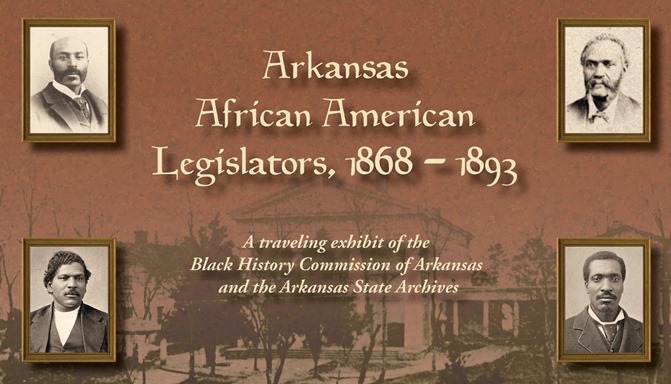More than 80 Black politicians were elected to statewide office in the late 1800s.

A traveling exhibit on display at the Old State House Museum in Little Rock showcases the history of African American politicians in the state. Produced by the Arkansas State Archives and the Black History Commission of Arkansas, Arkansas African American Legislators, 1868-1893, tells the story of 86 African Americans who served in the Arkansas General Assembly in the 19th century.
Arkansas adopted a new constitution in 1868, and its provisions included giving Black males the right to vote and hold public office. African American lawyers, merchants, ministers, educators, farmers and other professionals served in the Arkansas General Assembly, according to the Arkansas State Archives.
David Ware is the Arkansas State Historian and the director of the Arkansas State Archives. For a long time, Ware says the perception was African Americans didn’t end up in the legislature until the mid 1970s when Jerry Jewell became the first African American elected to the Arkansas Senate in the 20th century. However, Ware says African Americans participated in state government long before that.
“It’s pretty darn impressive seeing the numbers of African Americans, and more recently, the ones who have made a real impact in Arkansas politics,” Ware says.
-

Benjamin F. Adair, Pulaski County 1891 (House) Photo provided by Arkansas State Archives -

George W. Bell, Desha County, 1891, 1893 (Senate) Photo provided by Arkansas State Archives.
Historians have long discussed African American legislators in the 1800s in vague terms, but Ware says they never actually got around to counting them. In Arkansas, that changed when Blake Wintory published an article in 2006 that did just that. His work helped inform the exhibit, which has been traveling around the state for about a decade.
The easiest way to get a head count is by looking at legislative composite portraits, Ware says, however there are no existing copies for a number of the sessions in the 19th century. As such, Ware is not discounting the possibility there could have been more African American legislators than the 86 they’ve been able to identify.
In his research, Wintory also used census records to identify more legislators by searching for politicians who identified as Black, Negro or mulatto, Arkansas State Archives curator Julienne Crawford says.
“Several of them are mulatto and if you were just to look at the composite photo, you wouldn’t necessarily identify them as Black, that they are of mixed race,” she says.
Crawford and a colleague were able to track down photographs of 46 legislators, which are included in the exhibit as well as on a plastic ruler they pass out to school children. Tatyana Oyinloye, African American History Coordinator for the Arkansas State Archives, has passed out this ruler at events and says some adults have been surprised to learn they are related to these legislators.
“It’s very exciting when you learn about history because I’ve always said, if you don’t know where you’re from, you don’t know where you’re going,” Oyinloye says. “So to know your history is awesome.”
-

Isaac G. Bailey, Desha County, 1885 (House) Photo provided by Arkansas State Archives -

William H. Grey, Phillips County, 1868-1869 (House) Photo provided by Arkansas State Archives.
African American history isn’t taught in a lot of schools, so many people don’t know this piece of Arkansas history, Oyinloye says. Prior to COVID-19, Oyinloye went into schools to teach African American history and says it’s amazing what students don’t know.
Typically, most students name Martin Luther King Jr. when asked to name a famous Black person, but Oyinloye wants students to know there are others besides King. During presentations, she uses landmarks around Little Rock like streets and schools students are familiar with to expand their knowledge of African American history.
“The kids would get real excited so then they can retain that,” Oyinloye says. “And so at the end of my presentation I always ask them to name somebody that they didn’t know.”
For younger students, Oyinloye teaches about African American inventors like Lyda Newman who patented an improved hairbrush design in New York City in 1898. While children may not remember the inventor’s name, Oyinloye says they’ll remember that the household item, in this case a hairbrush, was created by a Black inventor.
“I haven’t been able to do that since COVID so, I’m missing that part of my job,” she says.
While Oyinloye may not be able to instruct students in person, children and their families can still learn about African American history through the Arkansas State Archives’ traveling exhibit. Arkansas African American Legislators, 1868-1893, is on display through Jan. 27 at the Old Statehouse Museum in Little Rock. Admission is free.
The exhibit will then move to the St. Francis County Museum in Forrest City where it will be on view Feb. 2-26. Masks and social distancing are required at both museums.
More information about the traveling exhibit is available on the Arkansas State Archives website.





